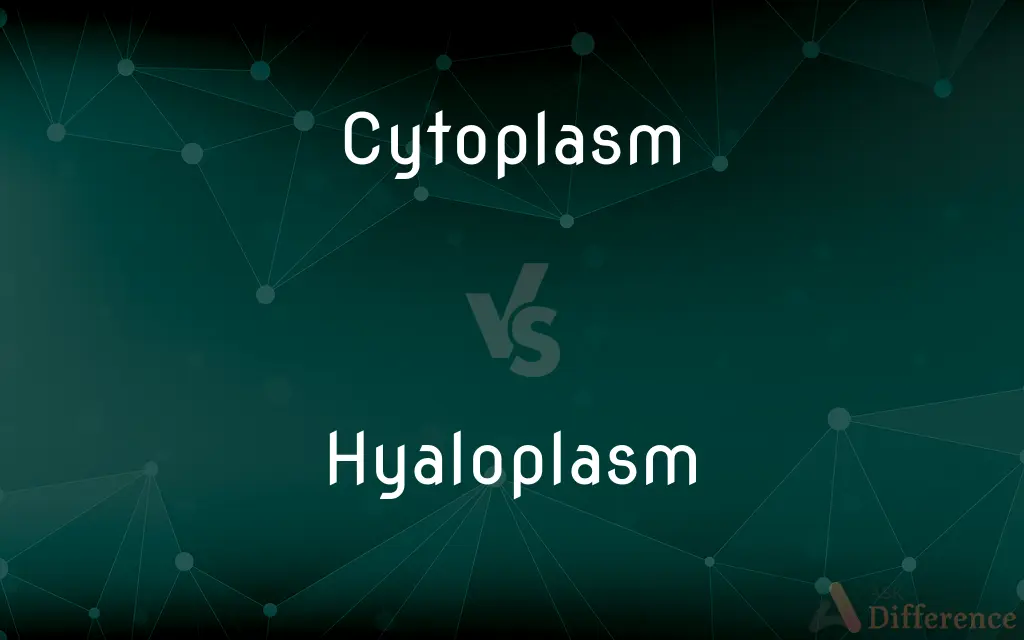Cytoplasm vs. Hyaloplasm — What's the Difference?
By Fiza Rafique & Maham Liaqat — Updated on April 5, 2024
Cytoplasm is the gel-like substance inside cells, holding organelles, while hyaloplasm is its clear, fluid portion.

Difference Between Cytoplasm and Hyaloplasm
Table of Contents
ADVERTISEMENT
Key Differences
Cytoplasm encompasses the entire content within a cell's membrane, excluding the nucleus, providing a medium where cellular processes occur. It consists of cytosol (the fluid portion), organelles (except the nucleus), and inclusions. Whereas hyaloplasm, or cytosol, is the transparent, jelly-like substance that forms the fluid component of the cytoplasm, facilitating the movement of materials and organelles within cells.
The cytoplasm plays a crucial role in cellular metabolism and contains enzymes that catalyze various reactions, including glycolysis and protein synthesis. It also provides a site for many biochemical processes. On the other hand, hyaloplasm, being part of the cytoplasm, acts as a medium for these reactions but lacks the organelles and structures that carry out these processes.
Organelles within the cytoplasm, such as mitochondria, endoplasmic reticulum, and Golgi apparatus, perform specific functions critical for the cell's survival and function. Hyaloplasm, while it surrounds and supports these organelles, does not have a direct role in these cellular activities.
The cytoplasm's viscosity and composition can change in response to cellular activity and environmental conditions, affecting the cell's metabolism and functionality. Conversely, the hyaloplasm’s consistency is relatively stable, providing a consistent environment for cellular processes.
Cytoplasm's composition is complex, including proteins, ions, and various organic and inorganic compounds, contributing to its gel-like consistency and functionality. Hyaloplasm, though simpler in composition, facilitates the diffusion of small molecules and ions, aiding in transport and communication within the cell.
ADVERTISEMENT
Comparison Chart
Definition
The entire content within the cell's membrane, excluding the nucleus
The clear, fluid portion of the cytoplasm
Composition
Cytosol, organelles (except nucleus), and inclusions
Mostly water, dissolved ions, small molecules
Function
Supports cellular processes, metabolism, and provides a medium for organelles
Facilitates movement and communication within the cell
Viscosity
Varies, can be gel-like depending on the cell type and condition
Generally less viscous, more fluid-like
Role in Cell
Integral to cell’s structure and function, hosting biochemical processes
Primarily serves as a solvent and medium for molecular movement
Compare with Definitions
Cytoplasm
Medium for cellular processes.
Enzymatic reactions critical for metabolism occur in the cytoplasm.
Hyaloplasm
Lacks organelles.
Unlike the rest of the cytoplasm, hyaloplasm is free of large organelles.
Cytoplasm
Supports organelles.
The cytoplasm holds organelles in place, ensuring proper cellular function.
Hyaloplasm
Facilitates diffusion.
Oxygen and carbon dioxide easily diffuse through the hyaloplasm.
Cytoplasm
Plays a role in cell division.
During cytokinesis, the cytoplasm is divided between the two daughter cells.
Hyaloplasm
Supports cellular shape.
Hyaloplasm contributes to maintaining the cell’s shape by exerting internal pressure.
Cytoplasm
The jelly-like substance within a cell.
The cytoplasm of a plant cell is where photosynthesis components are housed.
Hyaloplasm
The fluid portion of the cytoplasm.
The hyaloplasm's liquidity allows for easy transport of molecules across the cell.
Cytoplasm
Involved in cell movement.
Cytoplasmic streaming facilitates the distribution of nutrients and organelles within the cell.
Hyaloplasm
Medium for biochemical reactions.
Many soluble enzymes in the hyaloplasm catalyze reactions important for the cell's metabolism.
Cytoplasm
In cell biology, the cytoplasm is all of the material within a eukaryotic cell, enclosed by the cell membrane, except for the cell nucleus. The material inside the nucleus and contained within the nuclear membrane is termed the nucleoplasm.
Hyaloplasm
The clear fluid portion of cytoplasm as distinguished from the granular and netlike components. Also called ground substance.
Cytoplasm
The protoplasm enclosed by the plasma membrane of cell, excluding the nucleus in eukaryotic cells and cellular DNA in prokaryotic cells.
Hyaloplasm
(microbiology) A structureless fluid in cells; cytosol
Cytoplasm
(cytology) The contents of a cell except for the nucleus. It includes cytosol, organelles, vesicles, and the cytoskeleton.
Hyaloplasm
The clear nongranular portion of the cytoplasm of a cell
Cytoplasm
The substance of the body of a cell, as distinguished from the karyoplasma, or substance of the nucleus.
Cytoplasm
The protoplasm of a cell excluding the nucleus
Common Curiosities
Do all cells have hyaloplasm?
Yes, all cells with cytoplasm have hyaloplasm as it is the fluid component of the cytoplasm.
How does the cytoplasm support cellular metabolism?
It contains enzymes and organelles that catalyze and support metabolic processes.
What is the primary difference between cytoplasm and hyaloplasm?
The cytoplasm includes all contents within the cell membrane, while hyaloplasm refers specifically to its clear, fluid component.
Can hyaloplasm exist without cytoplasm?
No, hyaloplasm is a part of the cytoplasm and cannot exist independently.
Can changes in the cytoplasm affect cell function?
Yes, changes in composition or viscosity can impact cellular processes and overall functionality.
How do environmental conditions affect the cytoplasm?
Temperature, pH, and osmotic conditions can influence its viscosity and the rate of biochemical reactions.
What substances are primarily dissolved in hyaloplasm?
Water, ions, and small molecules like glucose and amino acids are typical constituents.
What role does hyaloplasm play in cell transport?
It facilitates the diffusion of molecules and ions within the cell, supporting transport and communication.
How do organelles remain suspended in the cytoplasm?
The cytoplasm’s gel-like structure and the cytoskeleton help maintain the position and stability of organelles.
Is the composition of hyaloplasm the same in all cells?
While the basic composition is similar, the concentration of ions and molecules can vary depending on the cell type and condition.
Why is cytoplasm important for cell division?
It contains the machinery and components necessary for dividing and distributing cell contents during cell division.
How is the cytoplasm involved in cellular signaling?
It contains signaling molecules and pathways that mediate responses to external stimuli.
Can the cytoplasm store substances?
Yes, it can contain inclusions and granules that store nutrients, waste products, and other materials.
Does hyaloplasm contain DNA?
No, DNA is located in the nucleus and certain organelles like mitochondria, not in the hyaloplasm.
Is the pH of cytoplasm and hyaloplasm the same?
Generally, yes, as hyaloplasm is part of the cytoplasm, but local variations can occur due to metabolic activities.
Share Your Discovery

Previous Comparison
Pension vs. Annuity
Next Comparison
Capful vs. CupfulAuthor Spotlight
Written by
Fiza RafiqueFiza Rafique is a skilled content writer at AskDifference.com, where she meticulously refines and enhances written pieces. Drawing from her vast editorial expertise, Fiza ensures clarity, accuracy, and precision in every article. Passionate about language, she continually seeks to elevate the quality of content for readers worldwide.
Co-written by
Maham Liaqat













































